Large dog breeds are a staple in many homes. Although I’ve always loved dogs of all shapes and sizes, I can’t help but favor the gentle giants.
Hi dog moms and dads! My name is Bri and my house wouldn’t be a home without my big American Bulldog/Pit Bull Terrier named Bruce.
When I wanted to adopt a dog, I knew I wanted a large breed.
I was leaning towards Pit Bull Terriers while I was looking, but when I met Bruce his mixed breed didn’t change the fact that he was the perfect dog for me.
Plus, he’s mostly Pit Bull so I still got the breed I wanted! It’s important to consider the breed you want when bringing a new dog into your home.
Large dogs will need plenty of space to roam around, as well as plenty of food to keep their big bellies full.
Although I do favor Pit Bull Terriers, there is another dog breed that also catches my eye called the Tibetan Mastiff. Let’s take a look at both breeds.
Tibetan Mastiffs Overview
Tibetan Mastiffs are huge, fluffy cuddle monsters. Sounds perfect, right? These big dogs fall under the Working Group and get up to a whopping 120 to 150 pounds.
Standing at a minimum of 26 inches tall, they look even bigger because of their long, fluffy fur.
Bred as guard dogs, this breed goes so far back that no one even knows the exact origin. They still act as guard dogs and are incredibly loyal and devoted to their family.
That being said, Tibetan Mastiffs are always suspect of strangers and need to be properly introduced. A home invader will definitely think twice with one of these in the home!
Surprisingly, these pups are extremely quick and agile. They are powerful and muscular dogs but are incredibly loving and sweet with their people.
Pit Bull Terrier Overview
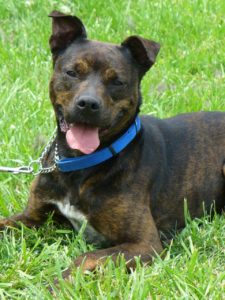 My favorite dog breed EVER is the pit bull.
My favorite dog breed EVER is the pit bull.
While pits have very distinct features, the breed itself is actually a mix of different bully breeds, such as American Bulldog (hello Bruce!), American Staffordshire Terrier, English Bull Terrier, and other bully breeds.
Pit Bulls have had a bad reputation for years because of the cruel sport called bull baiting.
As early as the 1600’s, England specifically bred bully breeds for this violent sport where the dog was put into a pit with a bull, and it was a fight to the death.
Although the sport was banned hundreds of years ago, breeding pit bulls for fighting was still an unfortunate problem that gave pit bulls a bad reputation and made people afraid of them.
Fortunately, fighting is starting to gain more awareness and harsher punishments, so it is not as common.
These pups are not any more aggressive than any other dog breed and are actually passing temperament tests and beating out family favorites like golden retrievers and border collies. Step aside Lassie!
Pits can vary in size according to what breeds they’re mixed with. For example, Bruce is a chunky boy weighing in at 90 pounds, but that comes from his American Bulldog background.
Most Pit Bulls average out around 60 to 65 pounds.
These dogs are the most loving and cuddly animals I have EVER come in contact with. If you sit on my couch, Bruce will be on your lap.
They are agile, high energy and love to explore the outdoors.
As an athletic dog, they make perfect companions for the outdoor enthusiasts, but they also love their indoor nap time for all the couch potatoes out there (I’m a good mix of both – and so is Bruce)!
Tibetan Mastiff vs Pit Bull Terrier Temperament and Training: How do They Behave?
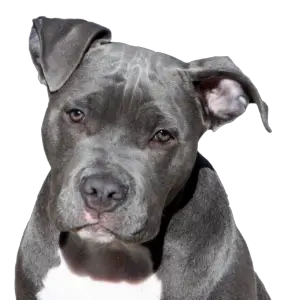 Both of these dogs are notorious for being loyal and loving to their families. When it comes to training, however, Pits are definitely easier to handle.
Both of these dogs are notorious for being loyal and loving to their families. When it comes to training, however, Pits are definitely easier to handle.
Tibetan Mastiffs are quick learners and extremely smart, so training needs to start very young. Once they learn their habits, they are likely to be set in their ways.
They don’t respond well to treats as training tools and will follow their instincts above any command given.
That being said, it’s highly recommended that this dog be strictly kept on a leash whenever they are out and about.
If you are struggling to train your dog we have created a great article which reviews Brain Training 4 Dogs an amazing programme that can teach your dog amazing tricks
If you would like to see our review of this click here!
Other than that, these big babies are just that – babies. They love to snuggle up with their people and are incredibly loyal.
These dogs need moderate daily exercise but are not going to respond much to fetch. They prefer work-related exercise, such as a nice walk around their property.
Their long fur makes them more active in cooler temperatures and less likely to be very active in warm weather.
Pit Bulls are very sweet and loving dogs that crave attention and will let you know it! They are pretty easy to train and respond very well to treats.
One thing to consider is that Pit Bulls absolutely NEED to be properly socialized with other dogs. Just like any other dog breed, if they aren’t, they can become territorial and aggressive towards other dogs.
This can add to the negative stigma against the breed.
These dogs are also heavy chewers and love to destroy their toys. I’ve gone through countless toys for Bruce and of course his favorite toys are stuffed animals, so I constantly have fluff all over my living room.
Keeping them occupied with the right toys is crucial to keep them from chewing things they shouldn’t in your home!
Otherwise, Pits are extremely active and high energy. They love to be outside and have high endurance, so they can go on long walks or hikes with no problem.
They also do well in any climate, but should wear protective layers in extreme cold since their short fur doesn’t offer much protection.
Tibetan Mastiff vs Pit Bull Terrier Health and Life Span: Life Expectancy & Common Health Conditions
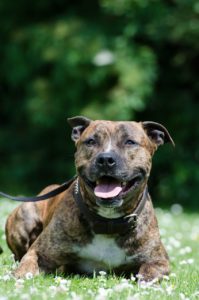 For a large dog breed, Tibetan Mastiffs have a pretty decent life span of 10 to 12 years. Pits also have a longer life span with an average of 12 to 14 years.
For a large dog breed, Tibetan Mastiffs have a pretty decent life span of 10 to 12 years. Pits also have a longer life span with an average of 12 to 14 years.
Both breeds are large, and any large dog should be regularly screened for hip, elbow, and thyroid evaluations.
Pits however are very commonly affected by allergies. We have supplements that Bruce takes every day to keep his itchy skin under control.
Pits can also be sensitive to certain foods like poultry and gluten.
The right diet and helpful supplements make handling allergies easy, but a vet’s advice should always be consulted!
Tibetan Mastiff vs Pit Bull Terrier Appearance: What do They Look Like?
When it comes to looks, these two breeds could not be more different.
Tibetan Mastiffs have long, extremely fluffy fur that can be black, tan, grey, or a mix of any of these colors.
They also don’t shed their coats, but “blow” an undercoat once a year. This takes place in late spring or summer and should be brushed with an undercoat rake to help them shed the excess fur.
Other than that, regular brushing (at least once or twice a week) is the only coat maintenance required for these fluffy beasts!

Pits have very short fur that sheds like crazy. Dog hair EVERYWHERE. But I’ve found that brushing Bruce with a good de-shedding tool has helped control his shedding a lot!
Pits come in many different colors, including gray, tan, white, and sometimes a mix of these colors or in a brindle pattern.
Bruce is commonly compared to a cow with his big black and white spots (his chubby belly doesn’t help – but he doesn’t mind)!
Although pits don’t necessarily need to be bathed more often than most dogs, I’ve personally found that regular baths have really helped with Bruce’s itchy skin.
I bathe Bruce once every two weeks with an anti-itch dog shampoo and conditioner and he loves his doggy spa days!
Obviously, Tibetan Mastiffs are probably better for folks with allergies than a Pit Bull Terrier because of the shedding.
Both breeds should have their nails trimmed regularly like any other dog, especially if they spend more time indoors than out.
Tibetan Mastiff vs Pit Bull Terrier Availability and Affordability: Are They a Rare, Expensive Dog Breed?
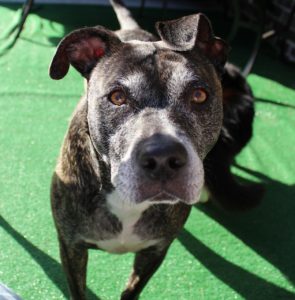 Tibetan Mastiffs are very unique dogs and are definitely not as common as Pits. Pit Bulls can be found extremely easily at any local animal shelter but are also a popular dog for breeding.
Tibetan Mastiffs are very unique dogs and are definitely not as common as Pits. Pit Bulls can be found extremely easily at any local animal shelter but are also a popular dog for breeding.
Tibetan Mastiffs are not hard to find but are definitely going to come more often from a breeder.
Since Pits are such a common breed, they typically won’t be as expensive to buy, especially if you rescue one from a shelter.
Tibetans, however, are a unique pure breed that are a little pricier from the start. Neither are too much of a financial burden once you get them started.
The only exception to that is if your Pit bull does experience severe allergies or food sensitivity. Sometimes, medication is the best option to help them through that which can be pricey.
We’ve been lucky to be able to find natural, over the counter supplements that work wonders for Bruce and aren’t expensive!
Tibetan Mastiff vs Pit Bull Terrier Diet: What do They Eat?
As I said earlier, Pits can have special food needs due to sensitive skin and common allergies.
I’ve found that Bruce is sensitive to chicken, so I have to make sure his food doesn’t contain any poultry.
It’s important for both dogs to have high protein diets since they are both muscular and athletic dogs.
As it is important not to overfeed your large dog breed we have created a great article on best weight management dog food for large breeds
Tibetan Mastiffs however should be fed a lighter diet because they are not as active as Pits.
Tibetans also eat less than you might think they would and only eat when they are hungry. Most adults only want 2 to 4 cups of food a day, but don’t normally need a special diet.
When it comes to treats, Pits will need the same attention to the type of treat as they do their food but are not picky!
Tibetans, however, don’t seem to respond much to treats. They also aren’t picky about their food.
Tibetan Mastiff vs Pit Bull Terrier Family Dog: Are They Good with Children?
Did you know that Pit bull were actually known as the nanny dog for many years? That’s because they are AMAZING with babies and kids.
Trust me – look up Pit Bulls and babies on YouTube. Don’t forget the tissues.
This breed is so incredibly cuddly and loving it melts my heart. I’ve never had a dog that cuddles as much as my Bruce does!
And of course, he has to sleep in the bed with us because anything less would be unacceptable.
Pits do well in a family that is active because they love walks and play time.
If you don’t have much spare time to give this dog the attention it needs, it might not be the dog for you!
Tibetans are similar in that they love their family and are great with kids. They are very protective of their families.
Tibetans need exercise for health reasons but are not considered heavy playing dogs or highly active for more than a few minutes at a time, so they don’t need as much attention (even though they still want all the love).
Tibetan Mastiff vs Pit Bull Terrier Environment: Where Are They Best Suited?

As large dog breeds, both of these dogs will need room to grow. However, neither are better suited in once style of home over the other – many people have both breeds in busy cities and in the countryside!
Pits can sometimes suffer from separation anxiety due to their strong bond with their humans. Normally, this can be pretty easy for them to grow out of.
Since I adopted Bruce, his separation anxiety is much worse due to abandonment in his past (I’m not crying you’re crying).
We give him calming chews when he needs them, and all is well!
Tibetans are much larger than Pits and might require more space, and definitely thrive in cooler climates.
Both breeds will need space to be walked and exercised, such as a nice dog park or big back yard!
I like having a fenced-in dog park for Bruce to be able to run around and burn off all his energy.
Final Thoughts: Tibetan Mastiff vs Pit Bull Terrier
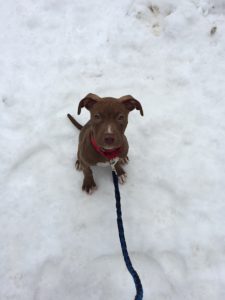 At the end of the day, both of these dog breeds make great pets.
At the end of the day, both of these dog breeds make great pets.
If you’re looking for a new protector for your family, both dogs have intimidating features, but a Tibetan Mastiff is sure to be more protective.
If you’re looking for a high energy companion to accompany you or your family members on all your adventures and get all the cuddles you could ask for, Pit Bull Terriers are definitely the dog for you.
Personally, I prefer a Pit Bull, but then again, I’m biased! I hope this helps you find the dog of your dreams! Happy Pet Parenting!

